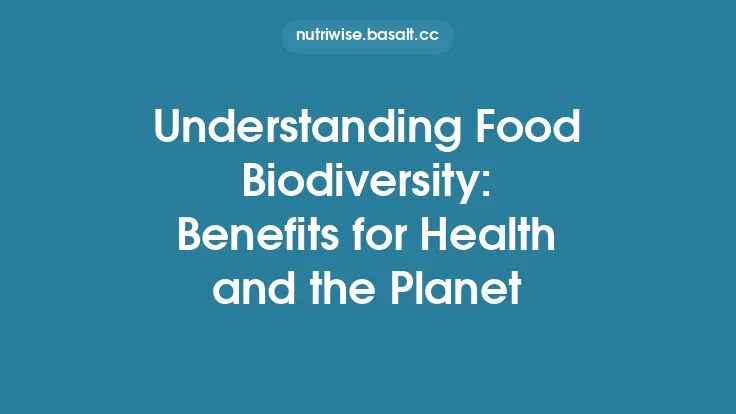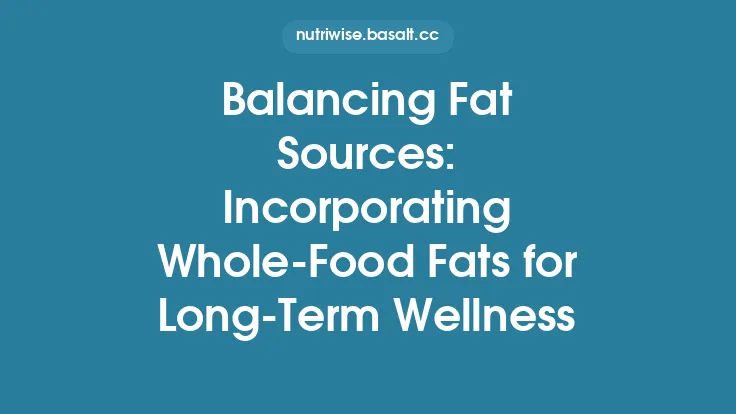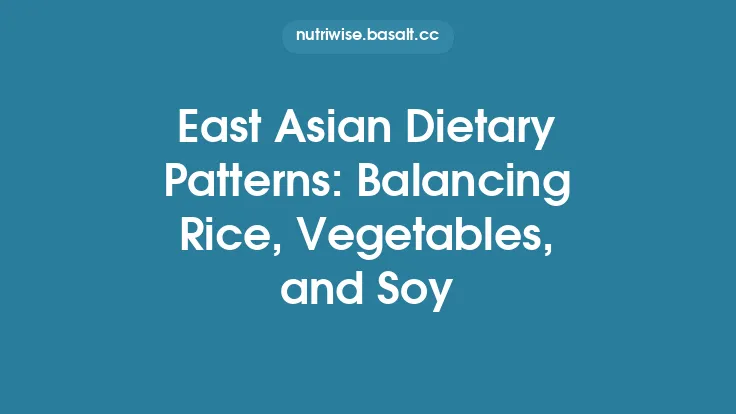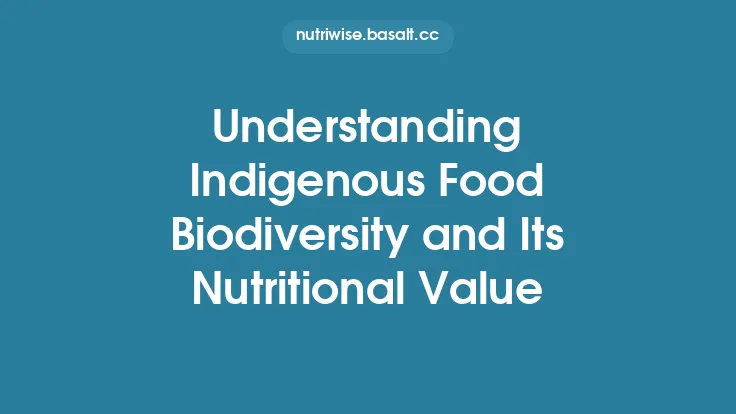Balancing the amount of meat and plant foods we eat is more than a personal health decision; it is a pivotal factor in the health of the planet’s ecosystems. When dietary patterns shift, the demand for agricultural land, water, and energy changes, and those shifts ripple through forests, grasslands, rivers, and oceans. Understanding the mechanisms by which meat and plant consumption intersect with biodiversity allows individuals, producers, and policymakers to make choices that protect species, preserve habitats, and maintain ecosystem functions for generations to come.
Why Diet Matters for Biodiversity
Biodiversity—the variety of life at genetic, species, and ecosystem levels—relies on the availability of habitats and the stability of ecological processes. Food production is the single largest driver of land‑use change worldwide, accounting for roughly 75 % of the global terrestrial surface. The composition of our diets determines how much land is devoted to livestock versus crops, which in turn influences:
- Habitat loss and fragmentation – Expanding pastures or feed‑crop fields often replaces native forests, wetlands, or savannas, directly reducing the area available for wildlife.
- Resource competition – Water and nutrients diverted to animal feed can limit the capacity of ecosystems to support native plant communities.
- Disturbance regimes – Intensive grazing or monoculture feed production can alter fire cycles, soil compaction, and nutrient cycling, affecting the species that depend on those processes.
By adjusting the balance between animal‑derived and plant‑derived foods, we can modulate these pressures and create a more favorable outlook for biodiversity.
Land‑Use Implications of Meat versus Plant Production
1. Direct Land Requirements
Livestock production is inherently land‑intensive. Ruminants such as cattle and sheep require grazing land, while all livestock depend on feed crops. On average, producing 1 kg of beef protein consumes 20–25 m² of land, whereas 1 kg of soy protein requires roughly 2 m². This disparity arises from the feed conversion ratio (FCR)—the amount of feed needed to generate a unit of animal protein.
2. Indirect Land Use (Feed Crops)
Even “grass‑fed” systems rely on supplemental feed during dry seasons, often sourced from soy, corn, or other cereals. The expansion of these feed‑crop areas frequently occurs at the expense of high‑biodiversity habitats such as tropical rainforests and temperate woodlands.
3. Opportunity Cost of Land
When land is allocated to livestock, it is unavailable for high‑biodiversity land‑uses such as mixed‑species agroforestry, natural grassland restoration, or conservation reserves. Reallocating a portion of this land to native vegetation can dramatically increase species richness and ecosystem resilience.
Greenhouse Gas Emissions and Species Survival
Meat production, particularly from ruminants, is a major source of methane (CH₄) and nitrous oxide (N₂O), both potent greenhouse gases. Climate change driven by these emissions threatens biodiversity through:
- Range shifts – Species must move to cooler habitats, often encountering fragmented landscapes that impede migration.
- Phenological mismatches – Altered timing of flowering, breeding, or migration can decouple ecological interactions (e.g., pollination, predator‑prey dynamics).
- Ocean acidification – Marine biodiversity suffers as increased CO₂ lowers pH, affecting coral reefs and shell‑forming organisms.
Reducing the proportion of high‑emission animal products in the diet can lower the carbon footprint of food systems, thereby mitigating climate‑related biodiversity loss.
Feed Conversion Ratios and Resource Efficiency
The feed conversion ratio (FCR) quantifies the efficiency with which an animal converts feed into edible protein. Typical FCRs are:
| Species | FCR (dry matter) |
|---|---|
| Beef cattle | 6–10 |
| Dairy cattle | 4–5 |
| Pork | 2.5–3 |
| Chicken | 1.5–2 |
| Fish (aquaculture) | 1–1.5 (depending on species) |
Higher FCRs mean more feed, water, and land are required per kilogram of meat, amplifying pressure on ecosystems. By favoring animal proteins with lower FCRs (e.g., poultry, certain fish) and integrating plant proteins, the overall resource demand can be reduced without sacrificing nutritional adequacy.
Sustainable Livestock Practices that Support Biodiversity
Not all animal agriculture is equally detrimental. Several management approaches can align livestock production with biodiversity goals:
- Rotational and Adaptive Grazing – Moving herds frequently mimics natural grazing patterns, promoting heterogeneous vegetation structure, enhancing soil carbon sequestration, and providing niches for insects, birds, and small mammals.
- Silvopasture – Integrating trees into pasture systems creates multi‑layered habitats, improves shade and shelter for animals, and supports forest‑dependent species.
- Mixed‑Species Grazing – Combining cattle, sheep, and goats exploits different grazing preferences, reducing overgrazing of any single plant species and maintaining plant diversity.
- Low‑Input, Pasture‑Based Systems – Minimizing synthetic fertilizers and pesticides reduces runoff that can degrade aquatic habitats and harms non‑target organisms.
- Regenerative Practices – Techniques such as cover‑cropping, compost application, and controlled stocking rates rebuild soil health, increase water infiltration, and foster resilient ecosystems.
When these practices are adopted at scale, they can transform livestock from a biodiversity stressor into a stewardship tool.
Integrating Plant‑Based Foods to Reduce Pressure
Increasing the share of plant foods in the diet does not require a complete abandonment of meat; rather, it calls for strategic substitution and complementarity:
- Protein Complementarity – Combining legumes (e.g., lentils, peas) with cereals (e.g., rice, wheat) yields a complete amino acid profile, reducing the need for animal protein while maintaining nutritional quality.
- Nutrient‑Dense Plant Foods – Dark leafy greens, nuts, seeds, and whole grains provide essential micronutrients (iron, zinc, B12 via fortified sources) that often motivate meat consumption.
- Culinary Innovation – Using plant‑based textures and flavors (e.g., mushroom “meat,” fermented soy products) can satisfy sensory expectations traditionally met by animal foods.
By thoughtfully incorporating these plant options, overall demand for livestock feed declines, freeing up land and resources for biodiversity‑friendly uses.
Nutritional Strategies for a Balanced Diet
A diet that supports biodiversity should also meet human health needs. Key considerations include:
- Moderate Meat Portions – Guidelines such as 100–150 g of cooked lean meat per day (or fewer) provide sufficient high‑quality protein while limiting excess intake.
- Diverse Plant Sources – Aim for at least five different plant food groups daily (vegetables, fruits, legumes, nuts/seeds, whole grains) to ensure a broad spectrum of phytonutrients.
- Omega‑3 Fatty Acids – Incorporate plant sources (flaxseed, chia, walnuts) and sustainably sourced fish (e.g., pole‑caught Alaskan salmon) to balance essential fatty acids without over‑reliance on high‑impact aquaculture.
- Micronutrient Monitoring – For individuals reducing red meat, monitor iron, zinc, and vitamin B12 status, supplementing where necessary, preferably with bioavailable forms (e.g., methylcobalamin for B12).
These strategies enable a diet that is both ecologically responsible and nutritionally sound.
Policy and Market Levers for Dietary Shifts
Governments, businesses, and civil society can accelerate the transition toward a balanced meat‑plant diet through:
- Fiscal Instruments – Taxes on high‑impact meat products and subsidies for sustainable plant‑based foods can reshape price signals.
- Public Procurement – Schools, hospitals, and government facilities can set procurement standards that favor lower‑impact protein sources.
- Labeling Schemes – Eco‑labels that disclose land‑use intensity, carbon footprint, or biodiversity impact empower consumers to make informed choices.
- Research Funding – Investment in breeding low‑FCR livestock, improving feed efficiency, and developing resilient plant protein crops supports long‑term sustainability.
- Education Campaigns – Nutrition and environmental education that highlights the biodiversity benefits of balanced diets can shift cultural norms.
When aligned, these levers create an enabling environment for widespread adoption of biodiversity‑friendly eating patterns.
Practical Steps for Consumers
- Adopt “Meat‑Free Days” – Designate specific days each week for entirely plant‑based meals.
- Choose Lower‑Impact Meats – Prioritize poultry, rabbit, or sustainably sourced fish over beef and lamb.
- Buy from Regenerative Farms – Seek certifications or farm statements that describe rotational grazing, silvopasture, or organic practices.
- Increase Legume Intake – Replace a portion of meat in familiar dishes (e.g., chili, tacos) with beans or lentils.
- Mind Portion Sizes – Use visual cues (a palm‑sized portion of meat) to keep consumption moderate.
- Support Local Plant Producers – Purchasing seasonal vegetables and grains reduces transport emissions and supports diversified cropping systems.
These actions, while individually modest, collectively generate significant reductions in the ecological footprint of food consumption.
Future Research Directions
- Life‑Cycle Assessment (LCA) Refinement – Developing region‑specific LCA models that incorporate biodiversity metrics (e.g., species‑area curves) will improve decision‑making.
- Genomic Tools for Feed Efficiency – Leveraging animal genetics to lower FCR without compromising welfare can reduce land and resource demands.
- Ecosystem Service Valuation – Quantifying the monetary value of biodiversity services preserved through dietary changes can strengthen policy arguments.
- Consumer Behavior Modeling – Understanding the psychological drivers behind meat consumption can inform more effective communication strategies.
- Integration of Agroecology and Nutrition – Interdisciplinary studies that link farm‑level biodiversity outcomes with human health outcomes will provide holistic guidance.
Continued investigation in these areas will refine our ability to balance dietary preferences with the imperative to conserve the planet’s living diversity.
By thoughtfully calibrating the proportion of meat and plant foods we consume, we can alleviate the primary pressures that agriculture places on ecosystems. The result is a win‑win: healthier people, more resilient food systems, and a richer tapestry of life thriving across the globe.





